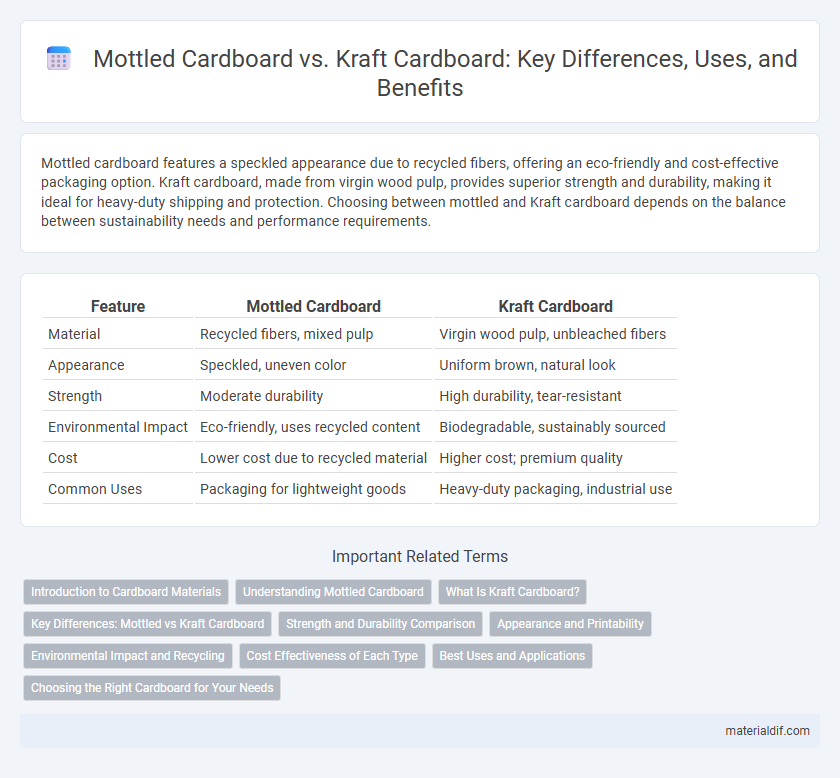Mottled cardboard features a speckled appearance due to recycled fibers, offering an eco-friendly and cost-effective packaging option. Kraft cardboard, made from virgin wood pulp, provides superior strength and durability, making it ideal for heavy-duty shipping and protection. Choosing between mottled and Kraft cardboard depends on the balance between sustainability needs and performance requirements.
Table of Comparison
| Feature | Mottled Cardboard | Kraft Cardboard |
|---|---|---|
| Material | Recycled fibers, mixed pulp | Virgin wood pulp, unbleached fibers |
| Appearance | Speckled, uneven color | Uniform brown, natural look |
| Strength | Moderate durability | High durability, tear-resistant |
| Environmental Impact | Eco-friendly, uses recycled content | Biodegradable, sustainably sourced |
| Cost | Lower cost due to recycled material | Higher cost; premium quality |
| Common Uses | Packaging for lightweight goods | Heavy-duty packaging, industrial use |
Introduction to Cardboard Materials
Mottled cardboard features a textured surface with a mix of light and dark fibers, providing a unique aesthetic ideal for packaging that requires visual interest and strength. Kraft cardboard, known for its durability and natural brown color, is produced from unbleached wood fibers, making it a popular choice for heavy-duty packaging and eco-friendly applications. Understanding the distinct fiber compositions and manufacturing processes of mottled versus Kraft cardboard is essential for selecting the right material based on strength, appearance, and environmental impact.
Understanding Mottled Cardboard
Mottled cardboard is characterized by its irregular, speckled appearance resulting from recycled fibers, which provides a unique texture and pattern compared to the uniform brown of Kraft cardboard. It is commonly used for eco-friendly packaging solutions, offering strength and durability while emphasizing sustainability through the use of post-consumer materials. Understanding mottled cardboard involves recognizing its environmental benefits, cost-effectiveness, and suitability for products requiring robust yet visually distinctive packaging.
What Is Kraft Cardboard?
Kraft cardboard is a sturdy type of paperboard made from kraft pulp, known for its high strength and durability due to the chemical pulping process that retains long wood fibers. It typically has a natural brown color and is widely used for packaging heavy or sharp-edged products because of its superior tear resistance and load-bearing capacity. Unlike mottled cardboard, which often contains recycled fibers and varies in appearance, kraft cardboard offers consistent quality and greater structural integrity for industrial and commercial applications.
Key Differences: Mottled vs Kraft Cardboard
Mottled cardboard features a mixed, uneven texture and coloration due to recycled fiber content, making it less uniform but eco-friendly compared to Kraft cardboard. Kraft cardboard is manufactured using virgin wood fibers through the kraft process, resulting in a stronger, more durable material with a consistent brown color. The key differences lie in appearance, strength, and fiber origin, with Kraft favored for heavy-duty packaging and Mottled for cost-effective, sustainable applications.
Strength and Durability Comparison
Mottled cardboard features a blend of recycled fibers, offering moderate strength suitable for lightweight packaging, whereas Kraft cardboard is made from virgin wood fibers, providing superior tensile strength and enhanced durability for heavy-duty applications. Kraft cardboard's dense fiber composition grants it better resistance to wear, tearing, and moisture, making it ideal for shipping and storage needs requiring robust protection. The durability of Kraft cardboard outperforms mottled cardboard, especially in environments demanding sustained mechanical stress and long-term use.
Appearance and Printability
Mottled cardboard features a variegated, textured surface with irregular color patterns that can enhance visual interest but may challenge color accuracy in printing. Kraft cardboard exhibits a uniform brown, natural fiber appearance, providing a consistent background ideal for sharp, vibrant print output. Both types offer distinct visual aesthetics, with kraft being preferred for precise, high-quality printing, while mottled supports decorative, rustic designs.
Environmental Impact and Recycling
Mottled cardboard typically consists of recycled fibers, reducing the demand for virgin materials and lowering its environmental footprint compared to Kraft cardboard, which is often made from unbleached, virgin pulp but remains fully recyclable. The recycling process for mottled cardboard is efficient, as it supports a circular economy by reusing post-consumer waste, whereas Kraft cardboard's durability makes it ideal for multiple recycling cycles, contributing to waste reduction. Both types are biodegradable, but the carbon footprint of mottled cardboard is usually smaller due to its recycled content, making it a more sustainable choice in packaging and shipping.
Cost Effectiveness of Each Type
Mottled cardboard typically costs less due to its use of recycled fibers, making it a budget-friendly option for packaging with good durability. Kraft cardboard, made from virgin wood pulp, provides higher strength and resistance but comes at a premium price point. Businesses often choose mottled cardboard for cost efficiency in high-volume, low-weight shipments, while kraft cardboard is preferred for heavy-duty applications requiring superior protection.
Best Uses and Applications
Mottled cardboard is ideal for packaging that requires an aesthetic, textured appearance, often used in gift boxes, retail displays, and artistic projects due to its decorative surface. Kraft cardboard, known for its strength and durability, is preferred for heavy-duty shipping boxes, industrial packaging, and applications requiring high resistance to tearing and puncturing. Selecting between mottled and Kraft cardboard depends on the balance between visual appeal and structural performance needed for the specific packaging or manufacturing purpose.
Choosing the Right Cardboard for Your Needs
Mottled cardboard offers a textured, multi-tonal look ideal for packaging that requires an attractive, rustic appearance, while Kraft cardboard provides high durability and strength due to its unbleached wood fibers, making it perfect for heavy-duty shipping and industrial use. Selecting between mottled and Kraft cardboard depends on whether aesthetic appeal or structural integrity is the priority, with Kraft often preferred for its superior tear resistance and moisture durability. Consider specific requirements such as weight capacity, environmental impact, and branding when choosing the right cardboard for your packaging or shipping needs.
Mottled cardboard vs Kraft cardboard Infographic

 materialdif.com
materialdif.com